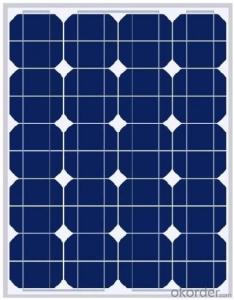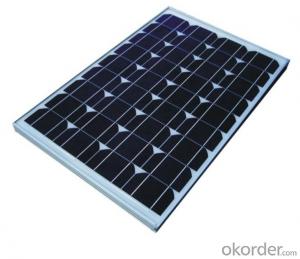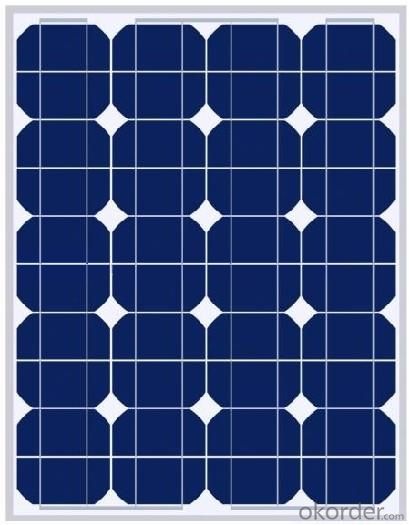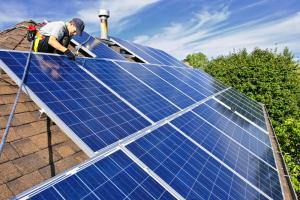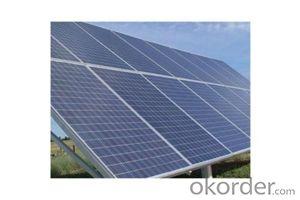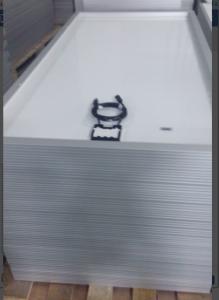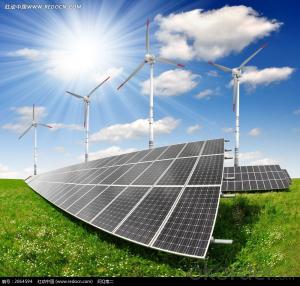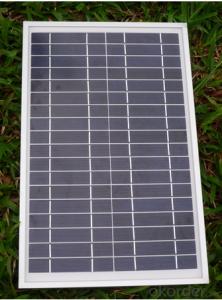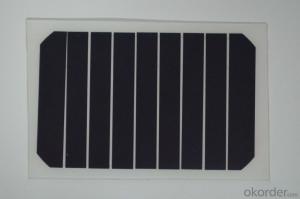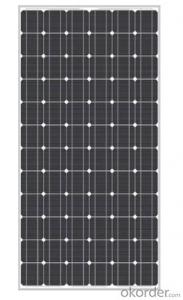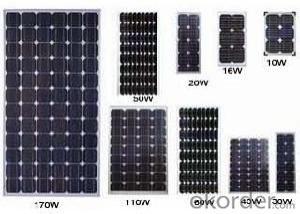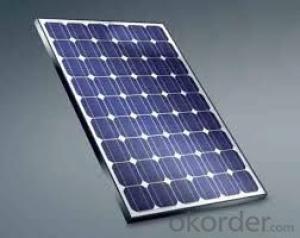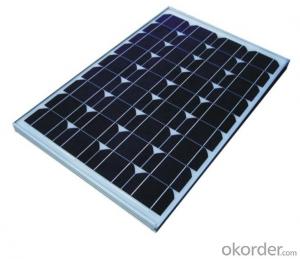Solar Panels Dallas Texas - Small Monocrystalline Solar Panel with 5W CNBM
- Loading Port:
- Qingdao
- Payment Terms:
- TT OR LC
- Min Order Qty:
- 10 set
- Supply Capability:
- 300000 set/month
OKorder Service Pledge
OKorder Financial Service
You Might Also Like
Small Monocrystalline Solar Panel with 5W
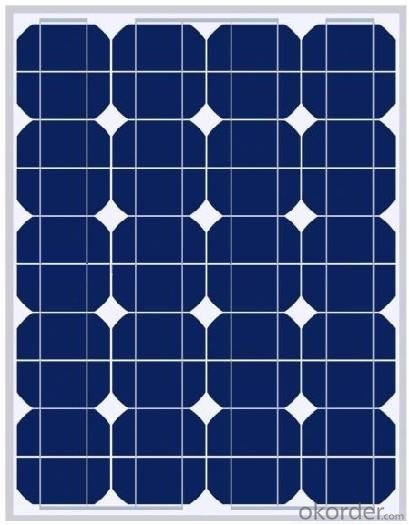
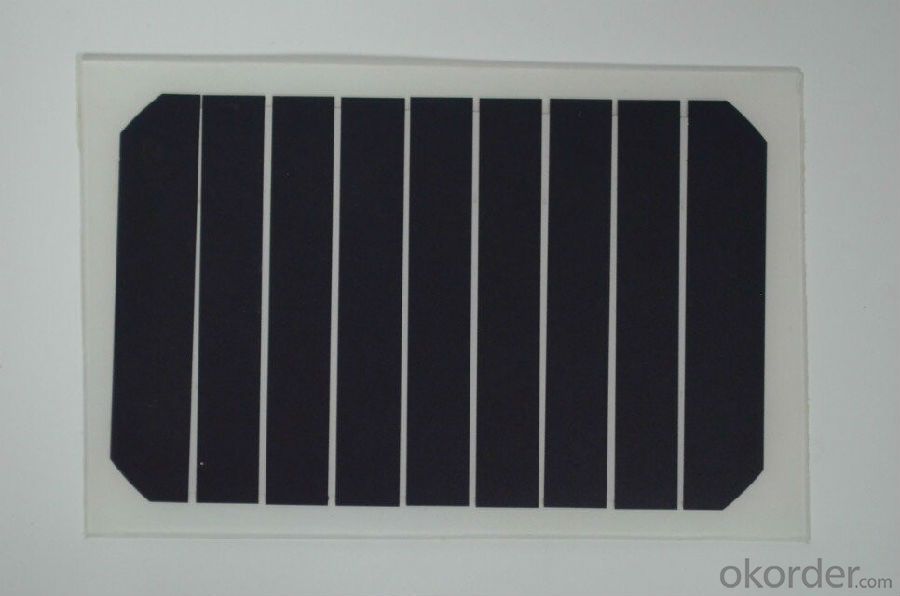
Quick Details
Place of Origin: | China (Mainland) | Brand Name: | CNBM | Model Number: | XRP-156M-250W |
Material: | Monocrystalline Silicon | Size: | 1620x992x40mm | Number of Cells: | 60 |
Max. Power: | 250w | Optimum Operating Voltage (Vmp): | 28.8V | Optimum Operating Current (Imp): | 8.68A |
Open Circuit Voltage (Voc): | 36V | Short Circuit Current (Isc): | 8.87A | Maximum Power at STC (Pmax): | 250W |
Operating Module Temperature: | -40 °C to +85 °C | Maximum System Voltage: | 1000 V DC (IEC) / 600V DC (UL) | Maximum Series Fuse Rating: | 15A |
Packaging & Delivery
Delivery Detail: | two weeks after order confirmation |
Features:
1) High Module conversion efficiency, through superior manufacturing technology
2) 0 to +5W positive tolerance for mainstream products
3) Certified to withstand high wind loads and snow loads
4) Anodized aluminum is for improving corrosion resistance
5) Anti-reflective, Highly transparent, low iron tempered glass
6) Excellent performance under low light environment
Benefit:
25-year performance warrant
10-year Product warranty
Electrical Characteristics:
Item No. | XRM-250W |
Optimum Operating Voltage (Vmp) | 28.8V |
Optimum Operating Current (Imp) | 8.68A |
Open Circuit Voltage (Voc) | 36V |
Short Circuit Current (Isc) | 8.87A |
Maximum Power at STC (Pmax) | 250W |
Cell Efficiency | 17.70% |
Operating Module Temperature | -40 °C to +85 °C |
Maximum System Voltage | 1000 V DC (IEC) / 600V DC (UL) |
Maximum Series Fuse Rating | 15A |
Power Tolerance | 0/+5 % |
STC: lrradiance 1000 W/m2, module temperature 25 °C, AM=1.5;
Best in Class AAA solar simulator (IEC 60904-9) used, power measurement uncertainty is within +/- 3%
Mechanical Characteristics:
No. of Cells | 60(6X10) |
Dimensions | 1640x992x40MM |
Weight | 20.0KGS |
Front | Glass 4.0 mm tempered glass |
Frame | Anodized aluminium alloy |
Temperature Characteristics:
Nominal Operating Cell Temperature (NOCT) | 45±2°C |
Temperature Coefficient of Pmax | -0.44 %/°C |
Temperature Coefficient of Voc | -0.33 %/°C |
Temperature Coefficient of Isc | 0.055 %/°C |
Refer to the Wmp range
Our factory can produce solar panel and solar module from 1.5W-290w (1.5w, 2.5w, 5w, 10w, 20w, 40w, 50w, 60w, 80w, 85w, 125w, 135w, 150w, 165w, 180w), according to customers requirement.
(A). Wmp range: 0.01W-6W, to be sealed with epoxy resin on PCB (printed circuit board), or to be sealed in plastic directly.
(B). Wmp range: 0.01W-15W, to be encapsulated with PET, on PCB (printed circuit board)
(C). Wmp range: 1W-60W, to be encapsulated with PET, on stainless steel, with holes for assembling purpose.
(D). Wmp range: 1W-290W, to be encapsulated with tempered glass, EVA, TPT, together with aluminium frame, junction box and (if necessary)diode and cable.
Refer to the material:
Monocrystalline solar cell or polycrystalline solar cell
Efficiency range 14%-17%, cell size 5/6.
- Q: Can solar panels be used for powering electric lawnmowers or gardening tools?
- Yes, solar panels can be used to power electric lawnmowers or gardening tools. They can be connected to a battery system that stores the solar energy and then powers the electric equipment. This provides a sustainable and eco-friendly alternative to traditional power sources.
- Q: Can solar panels be used for charging electric bikes?
- Yes, solar panels can be used to charge electric bikes. By converting sunlight into electricity, solar panels can provide a clean and renewable source of power for charging the batteries of electric bikes. This allows for sustainable and eco-friendly transportation options.
- Q: Can solar panels be used in areas with high pollution levels?
- Yes, solar panels can be used in areas with high pollution levels. While pollution levels may slightly reduce the efficiency of solar panels due to decreased sunlight reaching the panels, they can still generate electricity. Additionally, solar panels can help mitigate pollution by providing clean and renewable energy, reducing reliance on fossil fuels and contributing to a cleaner environment.
- Q: Hi! I bought a Coleman 2 vdc cooler that pulls 9 amps. What size solar panel and amp-hour battery do I need? I only open it 3 times a day. It will hold about 3 gals of milk.
- If it pulls 9 amps continuously, that's 08 watts/hour or about 2.5 kwh/day. If it only pulls half that (does it cycle?) it's about .2 kwh/day. You only want to drain a lead-acid battery 50% or so, so you'll want a 5 or 2.5 kwh battery pack. A typical setup for the 5 kwh would be two L-6 batteries in series, and for the 2.5 kwh you could use 2 T-05 batteries in series. This does not account for days of cloud. If you regularly have cloudy days, size the battery pack for two or three days of use with no input (2-3 x the sizes given above). To charge them, you typically want panels that will charge your battery at least 5% of its capacity per hour (C/20). For 2 volt nominal panels that's 0 amps for the T-05 or 20 amps for the L-6 batteries. It's good to have more than that for battery life (it cuts down on what's called stratification), so you'll want probably 50-200 watts of panels for the T-05 and 300-400 for the L-6. You'll also need a charge controller. Peltier coolers are very inefficient. You'll save money by using a regular mini-fridge and an inverter. Most mini-fridges only draw 50 watts or so, so you're talking 600 watt-hours for a 50% duty cycle. This means two T-05 batteries will give you two days of use and you'll only need 20-50 watts of panel. DK
- Q: The battery is 9ah and the solar panel is 20w
- You need a switch mode voltage converter, made to input 2 to 20 volts, and output around 7 volts. Some cell phone chargers can do that, or be modified for that voltage. Option B is to get another battery and use the system at 2V, and regulate that to 6 or 5 volts for charging (you can directly use your car charger), with switch mode regulators. I would find that system to be more flexible. Getting an 8Ah would leave extra capacity. BTW, for a 9AH battery, 20W is kid of big. I have a 36Ah battery and a 20W panel, and that is good for it.
- Q: Can solar panels be used for street lighting?
- Yes, solar panels can be used for street lighting. Solar-powered street lights use photovoltaic panels to convert sunlight into electricity, which is then stored in batteries for use during the night. This renewable energy source helps to reduce electricity costs and carbon emissions associated with traditional street lighting systems.
- Q: i need to make a solar panel model for a project in science and i would like to know how to build a easy model at home that wont cost alot
- There are different types of solar panels. Photovoltaic for electricity, and thermal for heating water, and passive for heating air. So it would help if you would say what type you are going to build. Theere are a lot of videos on you tube on how to make solar panels. use the link below.
- Q: how does solar panels work?
- Solar panels collect solar radiation from the sun and actively convert that energy to electricity. Solar panels are comprised of several individual solar cells. These solar cells function similarly to large semiconductors and utilize a large-area p-n junction diode. When the solar cells are exposed to sunlight, the p-n junction diodes convert the energy from sunlight into usable electrical energy. The energy generated from photons striking the surface of the solar panel allows electrons to be knocked out of their orbits and released, and electric fields in the solar cells pull these free electrons in a directional current, from which metal contacts in the solar cell can generate electricity. The more solar cells in a solar panel and the higher the quality of the solar cells, the more total electrical output the solar panel can produce. The conversion of sunlight to usable electrical energy has been dubbed the Photovoltaic Effect. The photovoltaic effect arises from the properties of the p-n junction diode, as such there are no moving parts in a solar panel.
- Q: i'm making a small solar panel powered fan but it cant run the cellphone vibration motor even i have place two x2 solar panel.
- A solar cell's purpose is to generate electricity through the release of electrons from a material that is bombarded by electromagnetic radiation or photons. Most crystalline solar cells are sensitive to visible radiation from 400 - 700 nanometers, which correspond to 3. - .8 electron volts, of the visible region as shown by ACEPT W3 Group (999) and also into the near infrared spectrum. As the wavelength of the electromagnetic radiation increases, the amount of electron volts decreases. This means that infrared radiation has less electron volts than the visible spectrum of light (because it has a larger wavelength than visible light) and ultraviolet and gamma radiation has more electron volts than both the visible spectrum of light and infrared radiation (because they have a smaller wavelength than both infrared and visible light). Abramowitz, M., Davidson, M., Neaves, S. (2003) wrote that all forms of electromagnetic radiation originate from the atom which contain orbiting electrons around its nucleus. When those electrons absorb more external energy than they can contain in order to be stable, the extra energy is released in the form of an electromagnetic wave. That electromagnetic wave contains a magnetic field and an electric field, one offset by ninety degrees to the other along the propagation plane.
- Q: I was having a discussion with a friends about solar panels.He says that if there is a solar panel (sp) on the ground and a solar panel (sp2) high in the atmosphere (in the stratosphere) the difference in power output between sp and sp2 negligible. I said that there would be a large difference in power output because sp has all of the atmosphere to block the suns rays and sp2 has very little atmosphere because it is very high up (in the stratosphere) therefore more sun can get to the panel and more power is produced.who is correct? many thanks in advance, please leave sources if possible, for validity.
- you are right , the solar painel higher in the atmosphere , gonna receive more solar warm , your friends are totaly wrong ,
Send your message to us
Solar Panels Dallas Texas - Small Monocrystalline Solar Panel with 5W CNBM
- Loading Port:
- Qingdao
- Payment Terms:
- TT OR LC
- Min Order Qty:
- 10 set
- Supply Capability:
- 300000 set/month
OKorder Service Pledge
OKorder Financial Service
Similar products
Hot products
Hot Searches
Related keywords
